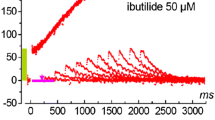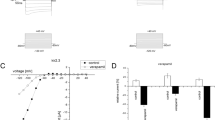Abstract
Protein kinase C (PKC) inhibitors are useful tools for studying PKC-dependent regulation of ion channels. For this purpose, high PKC specificity is a basic requirement excluding any direct interaction between the PKC inhibitor and the ion channel. In the present study, the effects of two frequently applied PKC inhibitors, chelerythine and bisindolylmaleimide I, were studied on the rapid and slow components of the delayed rectifier K+ current (I Kr and I Ks) in canine ventricular cardiomyocytes and on the human ether-à-go-go-related gene (hERG) channels expressed in human embryonic kidney (HEK) cells. The whole cell version of the patch clamp technique was used in all experiments. Chelerythrine and bisindolylmaleimide I (both 1 μM) suppressed I Kr in canine ventricular cells. This inhibition developed rapidly, suggesting a direct drug–channel interaction. In HEK cells heterologously expressing hERG channels, chelerythrine and bisindolylmaleimide I blocked hERG current in a concentration-dependent manner, having EC50 values of 0.11 ± 0.01 and 0.76 ± 0.04 μM, respectively. Both chelerythrine and bisindolylmaleimide I strongly modified gating kinetics of hERG—voltage dependence of activation was shifted towards more negative voltages and activation was accelerated. Deactivation was slowed by bisindolylmaleimide I but not by chelerythrine. I Ks was not significantly altered by bisindolylmaleimide I and chelerythrine. No significant effect of 0.1 μM bisindolylmaleimide I or 0.1 μM PMA (PKC activator) was observed on I Kr arguing against significant contribution of PKC to regulation of I Kr. It is concluded that neither chelerythrine nor bisindolylmaleimide I is suitable for selective PKC blockade due to their direct blocking actions on the hERG channel.





Similar content being viewed by others
References
Busch AE, Kavanaugh MP, Varnum MD, Adelman JP, North RA (1992) Regulation by second messengers of the slowly activating, voltage-dependent potassium current expressed in Xenopus oocytes. J Physiol 450:491–502
Cho H, Youm JB, Earm YE, Ho W-K (2001) Inhibition of acetylcholine-activated K+ current by chelerythrine and bisindolylmaleimide I in atrial myocytes from mice. Eur J Pharmacol 424:173–178
Fabiato A, Fabiato F (1979) Calculator programs for computing the composition of the solutions containing multiple metals and ligands used for experiments in skinned muscle cells. J Physiol Paris 75:463–505
Gintant G (1996) Two components of delayed rectifier current in canine atrium and ventricle. Circ Res 78:26–37
Heath BM, Terrar DA (2000) Protein kinase C enhances the rapidly activating delayed rectifier potassium current, IKr, through a reduction in C-type inactivation in guinea-pig ventricular myocytes. J Physiol 522:391–402
Honoré E, Attali B, Romey G, Heurteaux C, Ricard P, Lesage F, Lazdunski M, Barhanin J (1991) Cloning, expression, pharmacology and regulation of a delayed rectifier K+ channel in mouse heart. EMBO J 10:2805–2811
Kang TM (2008) PKC-independent stimulation of cardiac Na+/Ca2+ exchanger by staurosporine. Korean J Physiol Pharmacol 12:259–265
Kathöfer S, Röckl K, Zhang W, Thomas D, Katus H, Kiehn J, Kreye V, Schoels W, Karle C (2003) Human beta3-adrenoreceptors couple to KvLQT1/MinK potassium channels in Xenopus oocytes via protein kinase C phosphorylation of the KvLQT1 protein. Naunyn Schmiedebergs Arch Pharmacol 368:119–126
Kim AK, Bae YM, Kim J, Kim B, Ho W-K, Earm YE, Cho SI (2004) Direct block by bisindolylmaleimide of the voltage-dependent K+ currents of rat mesenteric arterial smooth muscle. Eur J Pharmacol 483:117–126
Li G-R, Feng J, Yue L, Carrier M, Nattel S (1996) Evidence for two components of delayed rectifier K+ current in human ventricular myocytes. Circ Res 78:689–696
Magyar J, Bányász T, Szigligeti P, Körtvély Á, Jednákovits A, Nánási PP (2000) Electrophysiological effects of bimoclomol in canine ventricular myocytes. Naunyn Schmiedebergs Arch Pharmacol 361:303–310
Matavel A, Lopes CM (2009) PKC activation and PIP2 depletion underlie biphasic regulation of IKs by Gq-coupled receptors. J Mol Cell Cardiol 46:704–712
Mellor H, Parker PJ (1998) The extended protein kinase C superfamily. Biochem J 332:281–292
Park WS, Son YK, Ko EA, Ko JH, Lee HA, Park KS, Earm YE (2005) The protein kinase C inhibitor, bisindolylmaleimide (I), inhibits voltage-dependent K+ channels in coronary arterial smooth muscle cells. Life Sci 77:512–527
Robinson RB, Liu QY, Rosen MR (2000) Ionic basis for action potential prolongation by phenylephrine in canine epicardial myocytes. J Cardiovasc Electrophysiol 11:70–76
Szabó G, Szentandrássy N, Bíró T, Tóth IB, Czifra G, Magyar J, Bányász T, Varró A, Kovács L, Nánási PP (2005) Asymmetrical distribution of ion channels in canine and human left ventricular wall: epicardium versus midmyocardium. Pflügers Arch 450:307–316
Szentadrássy N, Bányász T, Bíró T, Szabó G, Tóth B, Magyar J, Lázár J, Varró A, Kovács L, Nánási PP (2005) Apico-basal inhomogeneity in distribution of ion channels in canine and human ventricular myocardium. Cardiovasc Res 65:851–860
Thomas D, Zhang W, Wu K, Wimmer AB, Gut B, Wendt-Nordal G, Kathöfer S, Kreye VA, Katus HA, Schoels W, Kiehn J, Karle CA (2003) Regulation of HERG potassium channel activation by protein kinase C independent of direct phosphorylation of the channel protein. Cardiovasc Res 59:14–26
Thomas D, Wu K, Wimmer AB, Zitron E, Hammerling BC, Kathöfer S, Lueck S, Bloehs R, Kreye VA, Kiehn J, Katus HA, Schoels W, Kübler W, Karle CA (2004a) Activation of cardiac human ether-a-go-go related gene potassium currents is regulated by alpha(1A)-adrenoceptor. J Mol Med 82:826–837
Thomas D, Hammerling BC, Wimmer AB, Wu K, Ficker E, Kuryshev YA, Scherer D, Kiehn J, Katus HA, Schoels W, Karle CA (2004b) Direct block of hERG potassium channels by the protein kinase C inhibitor bisindolylmaleimide I (GF109203X). Cardiovasc Res 64:467–476
Toda H, Ding WG, Yasuda Y, Toyoda F, Ito M, Matsuura H, Horie M (2007) Stimulatory action of protein kinase C epsilon isoform on the slow component of delayed rectifier K+ current in guinea-pig atrial myocytes. Br J Pharmacol 150:1011–1021
Tohse N, Kameyama M, Sekiguchi K, Shearman MS, Kanno M (1990) Protein kinase C activation enhances the delayed rectifier potassium current in guinea-pig heart cells. J Mol Cell Cardiol 22:725–734
Voutilainen-Myllyla S, Tavi P, Weckström M (2003) Chelerythrine and bisindolylmaleimide I prolong cardiac action potentials by protein kinase C-independent mechanism. Eur J Pharmacol 466:41–51
Xiao GQ, Mochly-Rosen D, Boutjdir M (2003) PKC isozyme selective regulation of cloned human cardiac delayed slow rectifier K current. Biochem Biophys Res Commun 306:1019–1025
Acknowledgements
Financial support for the studies was provided by grants from the Hungarian Research Fund (OTKA-K68457, OTKA-K75904, OTKA-K73160, CNK-77855), from the Medical and Health Science Center of University of Debrecen (MEC-14/2008), and the Hungarian Government (TÁMOP-4.2.1/B-09/1/KONV-2010-007).
Author information
Authors and Affiliations
Corresponding author
Rights and permissions
About this article
Cite this article
Harmati, G., Papp, F., Szentandrássy, N. et al. Effects of the PKC inhibitors chelerythrine and bisindolylmaleimide I (GF 109203X) on delayed rectifier K+ currents. Naunyn-Schmied Arch Pharmacol 383, 141–148 (2011). https://doi.org/10.1007/s00210-010-0584-8
Received:
Accepted:
Published:
Issue Date:
DOI: https://doi.org/10.1007/s00210-010-0584-8




